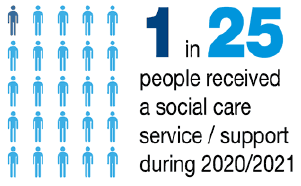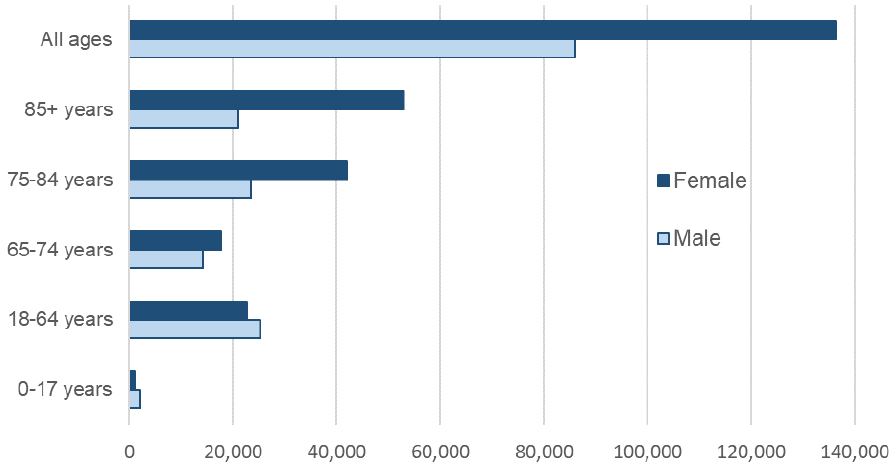National Care Service - people who access adult social care and unpaid carers: evidence
Provides an overview of key sources of evidence about people who access social care and unpaid carers in Scotland. It is part of a collection of contextual evidence papers, setting out key sources of information about social care and related areas in Scotland.
This document is part of a collection
2. Profile of people who access social care
The main source of information on people being supported by social care services is Public Health Scotland’s Insights in Social Care publication[1]. Social care services are defined as support or services which are provided or funded by the local authority to people who have had an assessment or review of their needs. These services can include community alarms, telecare, home care, day care and support to stay in a care home (see Glossary for further information).

The latest publication showed that an estimated 1 in 25 people of all ages in Scotland (231,925 people) were reported as receiving social care support and services at some point during 2020/21. This is a 2.5% decrease from 2019/20 but is still 0.8% higher than in 2017/18.
Source: Public Health Scotland (2022) Insights In Social Care: Statistics for Scotland 2019/20 – 2020/21
Information on age and gender was returned for 98% of records. Based on these records, over three-quarters (77%) of people being supported by social care services in 2020/21 were aged 65 and over and around three-fifths (61%) were female. This is consistent with previous years. There were more females than males in the older age groups (aged 65 and over) but for people aged 18 – 64 the gender split was more even, with slightly more males than females (Figure 1). Overall, 99% of people being supported by social care services in 2020/21 were adults (i.e. aged 18 or over).

Source: Public Health Scotland (2022) People supported - Insights in social care: statistics for Scotland - Support provided or funded by health and social care partnerships in Scotland 2019/20 - 2020/21
A previous data linkage study using the Social Care Survey[2] (which preceded the Public Health Scotland data collection), suggested that females may be more likely to receive social care from local authorities than males because they are more likely to survive their partners and so live alone. The latest publication from National Records of Scotland on Life Expectancy[3] also showed that in 2018-20 females had a life expectancy of 81.0 years, compared to 76.8 years for males. Since females have a higher life expectancy, this may explain why more females than males receive social care support in the older age groups.
The majority of people receiving social care support in 2020/21 (72%) were white, a similar proportion to previous years. Ethnicity was recorded as not known or not provided for around a quarter (26%) of people who access social care.
The Insights in Social Care publication also includes information by client group. This is determined by a Social Worker or Social Care Professional and is used as a means of grouping individuals with similar care needs. A person can be assigned to more than one client group. In 2020/21, the most common client group was “Elderly / Frail” (99,015 people) followed by “Physical and Sensory Disability” (76,605).
| Client Group | Number of people |
|---|---|
| Elderly / Frail | 99,015 |
| Physical and Sensory Disability | 76,605 |
| Other[4] | 42,085 |
| Learning Disability | 20,590 |
| Dementia | 15,275 |
| Mental Health | 14,445 |
| Not Recorded | 23,325 |
Source: Public Health Scotland (2022) People supported - Insights in social care: statistics for Scotland - Support provided or funded by health and social care partnerships in Scotland 2019/20 - 2020/21
People can receive multiple social care services as part of their care package. Based on data from the local authorities that submitted this information, it is estimated that 93,280 people received home care at some point in 2020/21. There were also an estimated 130,130 people with an active community alarm and/or telecare service and 127,500 people with a social worker.
| Type of service / support | Number of people |
|---|---|
| Community Alarms / Telecare | 130,130 |
| Social Worker | 127,500 |
| Home Care | 93,280 |
| Care Home | 48,160 |
| Day Care | 6,240 |
| Meals | 5,695 |
Source: Public Health Scotland (2022) People supported - Insights in social care: statistics for Scotland - Support provided or funded by health and social care partnerships in Scotland 2019/20 - 2020/21
According to the latest Free Personal and Nursing Care and Extension of Free Personal Care publications[5] produced by Scottish Government, 46,820 people aged 65 and over, and 12,110 people aged 18-64 received personal care at home in the last financial quarter of 2020/21 as part of their care package. This includes people assessed as having personal care needs who choose a direct payment or used Self-Directed Support (SDS) option 2 (see Glossary for further information) to purchase services in their own home, where information is available.
These publications also indicated that there were 10,420 self-funding care home residents aged 65 and over, and 120 self-funding care home residents aged 18-64 who received Free Personal Care payments. Local authority funded care home residents also receive personal care, but this will be included in the wider costs covered by the local authority.
Figures reported in the latest Care Home Census publication[6] showed that there were an estimated 33,353 residents in adult care homes as at 31st March 2021 (Table 3). This is around 11% lower than the number of residents reported in 2011. Over 90% (30,502) of residents in 2021 were in Older People care homes (this definition is based on the majority of residents in the care home). Around 96% (31,882) of residents were long-stay residents, around a third of whom were either mainly or fully self-funded.
| Total number of residents and client group split | Year at 31 March | % change 2011 to 2021 | % change 2019 to 2021 | ||||||||||
|---|---|---|---|---|---|---|---|---|---|---|---|---|---|
| 2011 | 2012 | 2013 | 2014 | 2015 | 2016 | 2017 | 2018 | 2019 | 2020 1 | 2021 | |||
| Total Number of Residents (Long Stay + Short Stay + Respite Residents) | 37,511 | 37,335 | 36,578 | 36,751 | 36,193 | 36,621 | 35,989 | 35,202 | 35,630 | n/a | 33,353 | -11.1% | -6.4% |
| Older People | 33,645 | 33,636 | 32,888 | 33,187 | 32,771 | 33,301 | 32,691 | 32,008 | 32,445 | n/a | 30,502 | -9.3% | -6.0% |
| Physical and Sensory Impairment | 555 | 528 | 554 | 537 | 531 | 525 | 568 | 621 | 611 | n/a | 511 | -7.9% | -16.4% |
| Mental Health Problems | 978 | 960 | 1,032 | 944 | 971 | 939 | 949 | 847 | 901 | n/a | 821 | -16.1% | -8.9% |
| Learning Disabilities | 2,102 | 1,962 | 1,859 | 1,821 | 1,659 | 1,603 | 1,542 | 1,469 | 1,413 | n/a | 1,291 | -38.6% | -8.6% |
| Other Groups | 231 | 249 | 245 | 262 | 261 | 253 | 239 | 257 | 260 | n/a | 228 | -1.3% | -12.3% |
| Total Number of Long Stay Residents | 36,002 | 35,775 | 34,933 | 35,012 | 34,482 | 34,738 | 34,101 | 33,223 | 33,637 | n/a | 31,882 | -11.4% | -5.2% |
| Older People | 32,545 | 32,555 | 31,752 | 31,943 | 31,547 | 31,872 | 31,223 | 30,487 | 30,914 | n/a | 29,317 | -9.9% | -5.2% |
| Physical and Sensory Impairment | 493 | 455 | 459 | 464 | 448 | 460 | 490 | 515 | 510 | n/a | 469 | -4.9% | -8.0% |
| Mental Health Problems | 916 | 883 | 947 | 893 | 909 | 904 | 924 | 814 | 865 | n/a | 798 | -12.9% | -7.7% |
| Learning Disabilities | 1,849 | 1,699 | 1,588 | 1,539 | 1,407 | 1,343 | 1,292 | 1,237 | 1,178 | n/a | 1,142 | -38.2% | -3.1% |
| Other Groups | 199 | 183 | 187 | 173 | 171 | 159 | 172 | 169 | 171 | n/a | 156 | -21.6% | -8.8% |
| Total Number of Short Stay and Respite Residents | 1,509 | 1,560 | 1,645 | 1,739 | 1,711 | 1,883 | 1,888 | 1,979 | 1,993 | n/a | 1,470 | -2.6% | -26.2% |
| Older People | 1,100 | 1,081 | 1,136 | 1,244 | 1,224 | 1,429 | 1,468 | 1,521 | 1,531 | n/a | 1,184 | 7.6% | -22.7% |
| Physical and Sensory Impairment | 62 | 73 | 95 | 73 | 83 | 65 | 78 | 106 | 101 | n/a | 42 | -32.3% | -58.4% |
| Mental Health Problems | 62 | 77 | 85 | 51 | 62 | 35 | 25 | 33 | 36 | n/a | 23 | -62.9% | -36.1% |
| Learning Disabilities | 253 | 263 | 271 | 282 | 252 | 260 | 250 | 232 | 235 | n/a | 149 | -41.1% | -36.6% |
| Other Groups | 32 | 66 | 58 | 89 | 90 | 94 | 67 | 88 | 89 | n/a | 72 | 125.0% | -19.1% |
The Insights in Social Care publication reported that a higher number of people (nearly 44,000) received funding towards a long stay care home place in Scotland during 2020/21 compared to the Care Home Census. It also showed that 6,300 people were supported during a short stay in a care home, such as for respite or for reablement in 2020/21. For people supported during a stay in a care home, 65% were female and nearly half were aged 85 and over. The data also indicated that 63% of people supported during a stay in a care home required nursing care.
It is important to note that the Insights in Social Care publication and the Care Home Census each cover different cohorts. The Insights in Social Care publication is based on returns from local authorities’ administrative data and so only includes people who were at least partly funded by the local authority throughout the year. The Care Home Census is based on returns from adult care homes as at the designated census date and so will include self-funders.
Contact
Email: SWStat@gov.scot
There is a problem
Thanks for your feedback